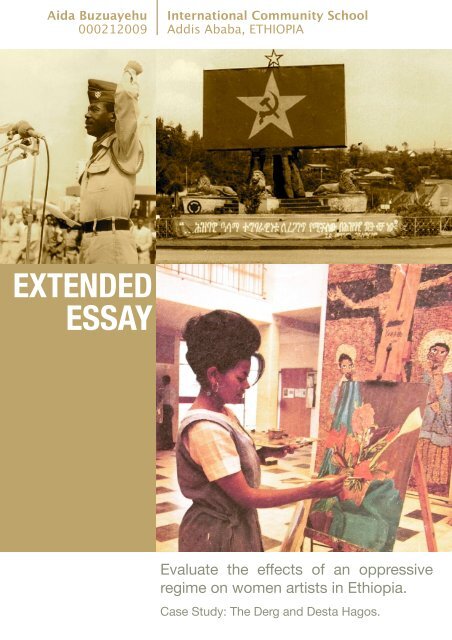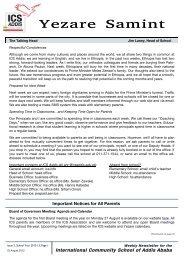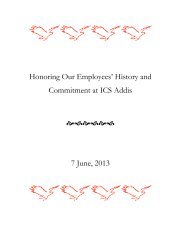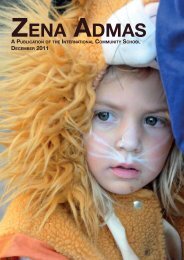Aida Buzuayehu - International Community School of Addis Ababa
Aida Buzuayehu - International Community School of Addis Ababa
Aida Buzuayehu - International Community School of Addis Ababa
Create successful ePaper yourself
Turn your PDF publications into a flip-book with our unique Google optimized e-Paper software.
<strong>Aida</strong> <strong>Buzuayehu</strong><br />
000212009<br />
EXTENDED<br />
ESSAY<br />
<strong>International</strong> <strong>Community</strong> <strong>School</strong><br />
<strong>Addis</strong> <strong>Ababa</strong>, ETHIOPIA<br />
Evaluate the effects <strong>of</strong> an oppressive<br />
regime on women artists in Ethiopia.<br />
Case Study: The Derg and Desta Hagos.
INTRODUCTION<br />
Art has always been and always will be a significant part <strong>of</strong> my life. Since I was<br />
an infant, I’ve always been fascinated by the idea <strong>of</strong> different colors, techniques, shades,<br />
and medias as well as the multiple forms <strong>of</strong> art including dance and music. It was due to<br />
my current participation in higher level art as well as my continuous curiosity and love<br />
for art that I decided to do my Extended Essay on Visual Arts. More specifically; I have<br />
a constant obsession with Ethiopian contemporary and fine art. I’ve always shared an<br />
undying passion for Ethiopian traditional crosses, ancient buildings, rock-hewn<br />
churches, unique cultures and the various magnificent cities that reside in the beautiful<br />
but isolated country, Ethiopia. Given the overall beauty that Ethiopia consists <strong>of</strong>, like<br />
every other nation, discrimination against gender was and to a certain extent still is a<br />
huge part <strong>of</strong> Ethiopian society. As a female with a great amount <strong>of</strong> passion for art this<br />
topic has had a powerful effect on me due to my feminist views and my aspiration to<br />
further promote women’s rights on the grounds <strong>of</strong> social, political and economic<br />
equality to men. This lead me to further investigate the difficulty and hardship female<br />
artists faced due to the communist military gang that came to power in Ethiopia in the<br />
1900’s, also known as the Derg. This topic is significant because discrimination against<br />
women isn’t advocated or promoted on a wide spectrum here in Ethiopia, thus making<br />
this topic worthy <strong>of</strong> investigation. Henceforth the evaluation <strong>of</strong> the effects <strong>of</strong> an<br />
oppressive regime, also known as the Derg, on female artists in Ethiopia is<br />
exceedingly essential.<br />
1
HISTORICAL BACKGROUND<br />
The Derg was a communist military party that came to power in Ethiopia after<br />
Emperor Haile Sellasie had temporarily left Ethiopia. It then ruled the country from<br />
1974 until 1987. ‘Derg’ in Amharic means ‘committee <strong>of</strong> the Armed Forces, Police, and<br />
Territory Army’ (Zewde, 55). It was these people that executed and imprisoned<br />
thousands <strong>of</strong> its rivals without a legitimate trial. The Derg was <strong>of</strong>ficially announced<br />
June 28 1974 by a group <strong>of</strong> military <strong>of</strong>ficers in order to maintain law and order. The<br />
cause <strong>of</strong> this perpetual dilemma is the impotency <strong>of</strong> the government following major<br />
decline in the armed forces <strong>of</strong> Ethiopia earlier that year. However the members <strong>of</strong> the<br />
Derg were not directly involved in this insurrection nor were this the first military<br />
committee established. In addition, over the following months revolutionary groups in<br />
the Ethiopian military came to the conclusion that the Emperor was acting on behalf <strong>of</strong><br />
the hated aristocracy, and when a group <strong>of</strong> notables petitioned for the release <strong>of</strong> a<br />
number <strong>of</strong> government ministers and <strong>of</strong>ficials who were under arrest for corruption and<br />
other crimes, the announcement <strong>of</strong> the Derg occurred (Zewde, 56). Although the<br />
emperor at the time was Emperor Haile Sellasie, there were in fact many other key<br />
figures in the regime. Oppressors such as Empress Taitu, Mengistu Haile Maryam as<br />
well as his wife etc, were vital people that caused major events in Ethiopian history. In<br />
the context <strong>of</strong> Ethiopia, Eastern Africa and Africa in general a woman in power is <strong>of</strong>ten<br />
an unsightly scenario. Women were oppressed and discriminated against for many<br />
years. However it hasn’t always been this way, in fact before the Derg women were<br />
2
‘equals’. Prior to 1974, women in Ethiopia were powerful and influential (Zewde, 56).<br />
Empress Taitu, was brought up in an aristocratic family where her father was famously<br />
known as Emperor Betul Haile Maryam. His daughter, Empress Taitu’s grandmother,<br />
was the daughter <strong>of</strong> Emperor Guga, the ruling family in the Oromo region. Evidently<br />
the Empress Taitu was a direct descendant <strong>of</strong> a royal family, <strong>of</strong> which most were women<br />
in power. After several failed marriages, Empress Taitu Betul married King Menelek <strong>of</strong><br />
Shewa and later Emperor Menelek II <strong>of</strong> Ethiopia (Zewde 60). Empress Taitu was known<br />
for her considerable political power as the wife <strong>of</strong> Menelek. Citizens were convinced<br />
that it was because <strong>of</strong> the head figure in place at the time, Haile Sellasie. Due to this<br />
controversy, students, most <strong>of</strong> which were art students protested through the streets <strong>of</strong><br />
<strong>Addis</strong> for the emperor to be changed (Zewde, 58). Shamefully, women artists never<br />
have been and currently aren’t very popular or common in the 20 th century. Desta<br />
Hagos, the first female artist to attain her own gallery in Ethiopia, has set the standard<br />
for other female artists here in Ethiopia. She has become an inspiration to many and<br />
continues to undertake and execute beautiful art till this day.<br />
Opening ceremony <strong>of</strong> one <strong>of</strong> Desta<br />
Hagos' solo exhibition at the Hilton Hotel,<br />
1994<br />
3
INTRODUCING THE ARTIST<br />
Desta Hagos was born in 1952 in a city by the name <strong>of</strong> Adwa. At the age <strong>of</strong> nine,<br />
she moved to the capital, <strong>Addis</strong> <strong>Ababa</strong> with her family and was enrolled in the Etege<br />
Menen Middle <strong>School</strong> (Woldearege, 16). She began to fall in love with art at the age <strong>of</strong><br />
five when she used to pick flowers from the garden to look at. “When I was just a tiny<br />
child I remember that I adored flowers and plants, and I loved to cut flowers so that I<br />
could look at and preserve their beauty at home,” she said while reminiscing her<br />
merciless love and cruel affection for beauty and colors. It was her father, one <strong>of</strong> her<br />
greatest muses in life that amended her atrocious habits. Her father would tell her,<br />
“Don’t kill the flowers; they have life like you. I will buy you coloring pencils and you<br />
can draw them exactly as they were alive.” (Woldearege, 16). Desta Hagos had a<br />
‘beautiful, love-filled and happy’ childhood while growing up in Ethiopia with four<br />
other siblings (Hagos, March 2011). At the age <strong>of</strong> fourteen, Hagos entered the<br />
<strong>International</strong> Children’s Arts Competition organized by the Indian embassy and won<br />
first place. She submitted three paintings, two <strong>of</strong> which were a landscape painting and<br />
one <strong>of</strong> a blind man (Hagos, March 2011).<br />
“Blind Man”<br />
Desta Hagos<br />
Tempera on paper<br />
1966<br />
4
Desta Hagos<br />
Graduation Day, 1969<br />
Similar to her father, Desta Hagos<br />
enjoyed listening to music and poetry as<br />
well as watching drama productions. The<br />
‘kirar’, an Ethiopian instrument that<br />
replicates the sound <strong>of</strong> a violin, had a<br />
positive effect on her artwork. Music,<br />
theater, dancing and performing arts in<br />
general influenced Desta’s art greatly.<br />
Desta Hagos, a talented artist grew up and<br />
received her diploma in Fine Arts in 1969 from<br />
the Fine Arts school. Soon after her graduation<br />
from the <strong>Addis</strong> <strong>Ababa</strong> <strong>School</strong> <strong>of</strong> Fine Arts, she<br />
was recognized as the first Ethiopian female<br />
artist to do a solo painting exhibition in<br />
Ethiopia. Desta commented that it was due to<br />
her love <strong>of</strong> music and the arts that she was able<br />
to gain such a title as she always uses music as a<br />
temperament in her artwork. “Listening to music<br />
has always been a backdrop for my artistic<br />
temperament,” (Hagos, May 2011).<br />
Desta Hagos performing at the<br />
University Cultural Center, 1967<br />
5
Desta Hagos at CLU, 1971<br />
Aside from this, one <strong>of</strong> her greatest<br />
inspirations and mentors in life was the<br />
infamous artist Gebre Kirstos Desta. Again<br />
being the only female, a couple years later<br />
she opened an art studio with four<br />
accomplished male artists at the University<br />
where she experienced becoming an actress.<br />
“I had no idea what I was doing. I just used<br />
to love watching plays. But artist Debebe<br />
Eshetu and the late Wogayehu Negatu<br />
encouraged me to try my hand at it,” (Hagos,<br />
May 2011). In January 1970, after several attempts at careers in performing arts, Desta<br />
traveled to the United States to attend the California Lutheran University (CLU) where<br />
she graduated with a B.A degree in Fine Arts. During a relaxed interview, when asked to<br />
describe her personality, she responded by saying, “I’ve always been a very social<br />
person; I had many friends all over the world. One <strong>of</strong> my friends in California has<br />
named her first blue-eyed, blonde daughter ‘Desta’ after me”. Clearly Desta was a<br />
cheerful person and a joy to be around. It was theses characteristics that allowed her to<br />
always end up amongst the top as the only female.<br />
6
During her enrollment at the university, Desta won a full scholarship during her<br />
second year, which enabled her to participate in four exhibitions during her four years<br />
<strong>of</strong> study at CLU (Mimi, 16). Two <strong>of</strong> the four exhibitions she accomplished on her own,<br />
at this time, an Ethiopian female artist with her own exhibition was a tremendous<br />
accomplishment, at least for Desta’s family (Teferra, 32). In 1975, Desta was yearning<br />
to return to her home country however in the middle <strong>of</strong> victory tragedy awaited her. She<br />
returned only to find her country afflicted by oppression and political tension. To make<br />
matters worse, the life <strong>of</strong> her ex-husband had been threatened so he had to leave the<br />
country. Shortly after his departure she learned that she was pregnant with his child.<br />
Once more, she was a lone woman in a distressing society, which caused her to<br />
temporarily put her art career on hold. She joined the Ethiopian Tourist Organization in<br />
“Pounding Pepper”<br />
Desta Hagos<br />
Acrylic and Tempera on canvas<br />
1982<br />
1976 and worked there until 1986 where she transferred to<br />
the Ethiopian Tourist Trading Enterprise as Acting Head <strong>of</strong><br />
the Promotion and Public Relations <strong>of</strong> the Artistic<br />
Department for many years (Mimi, 16). Fortunately after,<br />
her painting “Pounding Pepper”, a painting demonstrating a<br />
domestic scene that depicts women with infants tied to their<br />
backs while pounding pepper; a common sight in Ethiopia,<br />
was selected among other works <strong>of</strong> art from thirteen other<br />
African countries to be displayed in the Contemporary<br />
African Art Exhibition in Canada (Teferra, 32).<br />
7
An oppressive regime was not conducive to artistic development in Ethiopia as<br />
she was only able to do a few group exhibitions during the two decades in which the<br />
Derg situated. Undeniably, there were very few female artists in Ethiopia due to many<br />
circumstances. “The current situation in Ethiopia is not very encouraging. The lack <strong>of</strong><br />
economic growth is by itself an obstacle to the development <strong>of</strong> art. Artists are generally<br />
not well paid and society is quick to discourage them, especially if they are female.<br />
Women are taught to underestimate their own values and abilities so that it takes not<br />
only talent but also a great love for the art to continue working in this<br />
pr<strong>of</strong>ession” (Teferra, 32). Desta Hagos believes that females have important roles in<br />
Ethiopian society. “Art goes hand in hand with the development <strong>of</strong> society. In Ethiopia<br />
there was a great restriction against artistic expression during the previous regime,<br />
which isn’t the case anymore. The newfound freedom has allowed more artists to come<br />
out but there is still a lot to be done. Woman artists can contribute greatly to society and<br />
their works are <strong>of</strong>ten educational, they might for example reflect the constraint imposed<br />
on women from expressing themselves. Also art helps create confidence in our<br />
culture” (Teferra, 32). Despite her gender, Hagos was a fighter. Although the regime<br />
had changed many aspects <strong>of</strong> peoples lives, by talking land from people and<br />
imprisoning random citizens, in 1994 Hagos held her first solo exhibition in decades. “I<br />
worked day and night in order to display my paintings; I missed not showing my art for<br />
so long” (Hagos, May 2011). Later she began participating in several more exhibitions<br />
with famous contemporary Ethiopian artists known as Maitre Artist Afework Tekle, one<br />
8
<strong>of</strong> the most famous male artists at the time. Desta<br />
Hagos is a skilled fine artist as she uses music as<br />
her most prominent source <strong>of</strong> inspiration while<br />
producing works <strong>of</strong> abstract and semi-abstract.<br />
“Most <strong>of</strong> my works are semi-abstract and I use<br />
Ethiopian landscapes and day-to-day life as my<br />
subject matter” (Hagos, March 2010). “…Desta<br />
shows both a high degree <strong>of</strong> technical ability both<br />
rare and essential in an artist. She can make you stop and look. She can even make you<br />
see…” (Ethiopian Herald, 1969)<br />
Maitre Artist Afework Tekle, with<br />
Desta Hagos<br />
"Landscape"<br />
Desta Hagos<br />
Oil on canvas<br />
9
Henceforth, Desta Hagos is a remarkable woman. Circumstances and conditions beyond<br />
her control obligated her to face the world alone, and become a single mother. In both<br />
her career and her personal life, she was and still is one <strong>of</strong> the most successful and<br />
respected artists in Ethiopia. Despite the complications and disadvantages that the Derg<br />
imposed onto Desta Hagos, women and society in general, she was able to maintain her<br />
beautiful sense <strong>of</strong> worth as well as her promising and optimistic frame <strong>of</strong> mind.<br />
"Semi Abstract"<br />
Desta Hagos<br />
Oil on canvas<br />
10
LOOKING AT HER PAINTINGS<br />
Desta Hagos <strong>of</strong>ten features flowers in her paintings in order to convey the theme<br />
<strong>of</strong> feminism through the delicate and lurid look that flowers express.<br />
In this painting, Desta Hagos depicts her incessant love for flowers. The colors used<br />
exemplify life itself. Her father used to say “Don’t kill the flowers, they have life like<br />
you…”(Woldearege, 16). Her father’s advice influenced this piece greatly. Hagos uses a<br />
total <strong>of</strong> five colors to accomplish this piece; green, yellow, white, red and blue which<br />
ultimately gives the painting a more simple yet immensely complex meaning to it.<br />
“Flowers”<br />
Desta Hagos<br />
Acrylic on canvas<br />
1982<br />
11
“Exile” is another piece by Desta Hagos that depicts African refugees fleeing their<br />
homes, families and friends as a result <strong>of</strong> a man-made disaster. Here Desta Hagos<br />
employs historical context while giving reference to man-made disasters, The Derg. As<br />
shown in the painting, Hagos only features female characters in this painting in order to<br />
continually address the theme <strong>of</strong> feminism.<br />
“Exile”<br />
Desta Hagos<br />
Acrylic on canvas<br />
12
It’s a national tradition in Ethiopia to invite all you friends for a cup <strong>of</strong> c<strong>of</strong>fee and<br />
some popcorn. Women in Ethiopia usually bond over a cup <strong>of</strong> c<strong>of</strong>fee. Buna be Weray<br />
features several women talking. They all look happy but in reality they all have<br />
miserable lives at home and they get together once in a while in order to escape their<br />
lives, even if its just for a short while. Buna be Wetet meaning c<strong>of</strong>fee with milk is a very<br />
common beverage to drink at home usually on Sundays with popcorn. The title <strong>of</strong> this<br />
piece however is Buna be Weray meaning "c<strong>of</strong>fee with gossip".<br />
“Buna Be Weray”<br />
Desta Hagos<br />
Acrylic on canvas<br />
13
In Conspiracy by Desta Hagos, the expression on the protagonists face depicts intrigue,<br />
controversy and quarrel. Her face at first glance looks like she’s smiling but instead you<br />
see sadness and scheme. The fact that there are only girls in the painting denotes the fact<br />
that all women are feeling the same way and going through the same emotions.<br />
“Conspiracy”<br />
Desta Hagos<br />
Acrylic on canvas<br />
14
Abeba another piece by Desta Hagos is another flower piece. Abeba in Amharic<br />
means flower. It’s featuring a beautiful white daisy, which signifies purity and<br />
feminism. The fact that there are leaves and stems covering the flowers beauty so that<br />
the full beauty is hidden symbolizes the fact that society didn’t let women show their<br />
full potential. Woman aren’t granted the same opportunities and privileges as men.<br />
Going back to fact that women did not have as many rights as men and were not<br />
considered equals.<br />
“Abeba”<br />
Desta Hagos<br />
Acrylic on canvas<br />
15
This piece is a telltale in the sense that it automatically gives a visual indication <strong>of</strong><br />
women’s’ melancholy. The young girl in this piece, the protagonist <strong>of</strong> the painting is<br />
trying to write something but is unable to because her candle keeps burning out. There’s<br />
a person in the left hand corner that keeps blowing the candle out and there are lots <strong>of</strong><br />
used matches all over the table depicting the amount <strong>of</strong> times she’s tried. In this piece I<br />
believe Desta Hagos was trying to personify the misfortune, suffering and tribulation<br />
that females went through due to their gender. The person blowing out the candle<br />
personifies society as it never gave women a chance but us women, despite our<br />
adversity as shown by the young girls tears never gave up, hence the amount <strong>of</strong><br />
matches.<br />
“Melancholy”<br />
Desta Hagos<br />
Acrylic on canvas<br />
16
Hasab by Desta Hagos features a young woman in deep, complex thought. Hagos<br />
makes it semi abstract for the purpose <strong>of</strong> depicting the complexity and abstract <strong>of</strong> her<br />
thoughts. It’s a woman instead <strong>of</strong> a man because women encountered hardship not men.<br />
Henceforth the Derg clearly influenced her art<br />
“Hasab”<br />
Desta Hagos<br />
Acrylic on canvas<br />
17
OTHER FEMALE ARTISTS<br />
In this comparison I examine other Ethiopian contemporary female artists that<br />
perhaps experienced similar problems to Desta Hagos. Artists that paint traditionally<br />
and those taught in the academic and fine arts traditions. What these women have in<br />
common is the strength they’ve acquired in order to become artists as well as the<br />
challenges and hardships inflicted by a competitive, male-dominated market<br />
(Tecklemichael, 1). Another similarity these women might have is their relatively<br />
similar themes in most <strong>of</strong> their work that feature women as the main subject or<br />
protagonist <strong>of</strong> the piece. Similar to fine artist Desta Hagos, these women that I will later<br />
further examine, utilize their art as a way to signify the relationship between “the<br />
production <strong>of</strong> art and the exercise <strong>of</strong> social or political power”,(Teklemichael, 1). In<br />
other words they used their art as a way to achieve their goal <strong>of</strong> success (Teklemichael,<br />
2) but at the same time to enhance their significance and influence in society.<br />
Henceforth women used their art as a cry for help or recognition in a male-dominated<br />
society while making ‘women’ the subject matter <strong>of</strong> their pieces. Desta Hagos uses<br />
flowers and female characters as the subject matter in most <strong>of</strong> her art while using<br />
abstract and semi-abstract techniques. As previously stated, women have been the<br />
subject matter <strong>of</strong> various art pieces whether they’re religious or non religious.<br />
As journalist Makeda Tecklemichel mentioned in her article Contemporary<br />
women artists in Ethiopia, “St Mary plays the role <strong>of</strong> mother, Brutawit as a victim<br />
waiting to be saved by St George, the queen <strong>of</strong> Sheba as a royal woman used to<br />
18
legitimize the solomonic dynasty, and ordinary women as housewives and helpmates <strong>of</strong><br />
men, who all hold a significant place in Ethiopian art”. In summary, most <strong>of</strong> the art<br />
work during this era had hidden messages that reveled daily life as well as the daily<br />
activities and pursuit <strong>of</strong> the average Ethiopian Christian woman. All <strong>of</strong> these women<br />
weren’t given the opportunity to get proper art training due to various unfortunate<br />
circumstances. Instead they were to stay home and fulfill household tasks while<br />
receiving theological education simultaneously. Its crucial however to note that these<br />
women although not given the same opportunities as men, in terms <strong>of</strong> a higher<br />
education, were active advocates <strong>of</strong> other creative traditions typically produced by<br />
women (Teklemichael, 4). Things like pottery, basket making, textile weaving and<br />
embroidery. Sadly the people that produce these fabulous items are very rarely<br />
considered ‘artists’ (Teklemichael, 4).<br />
The five contemporary artists I have chosen to examine go by the names <strong>of</strong><br />
Woyzero Lemlem Gebremeskal, Emahoy Wolate-Yohannes Sebehatu, Yordanos<br />
Berhanemeskal, Elizabeth Habte-Wolde and Merikokeb Berhanu. Woyzero Lemlems’<br />
love for art like most artists began at a young age. “She began painting by using<br />
charcoal to draw pictures <strong>of</strong> animals and people on the mud walls <strong>of</strong> her<br />
house” (Teklemichael, 5). It was a priest passing by her home that discovered her talent<br />
and advised her to travel from her village to the nearest city to pursue her dreams <strong>of</strong><br />
becoming an artist. Although Woyzero Zelalem lacked former art training as well as a<br />
19
proper mentor, she didn’t let her gender or lack <strong>of</strong> proper materials stand in her way. It’s<br />
for these reasons that I believe she’s similar to Desta Hagos. The second artist, Emahoy<br />
Wolate-Yohannes Sebehatu fell in love with fine art as an adolescent who decided to<br />
become a nun, hence the prefix in her name ‘Emahoy’ which means nun in Amharic.<br />
She acquired her artistic skills while receiving theological education in one <strong>of</strong> the<br />
Churches located on Lake Tana. Similar to Desta Hagos and Woyzero Lemlem<br />
Gebremeskal, Emahoy grew up in a town without any painters or mentors which made<br />
it more difficult to pursue an art career with the additional burden <strong>of</strong> being female.<br />
However, Emahoy Wolate-Yohannes stood firm in her belief that painting is a gift from<br />
God and He gives this gift to both men and women (Teklemichael, 5).<br />
Desta Hagos posing next to her artworks<br />
Yordnos Berhanemeskal, the third artist<br />
I’ve chosen to introduce was born into an art family,<br />
unlike the other artists. Her father was the best-<br />
known artist <strong>of</strong> her time as she grew up surrounded<br />
by traditional and religious art, which has positively<br />
affected her. Her biggest inspiration, similar to Desta<br />
Hagos, was her father as she would sit behind him<br />
while he was painting and imitate the art he produced<br />
when he wasn’t home (Teklemicheal, 5). Yordanos is one <strong>of</strong> very few women that has<br />
received proper art training and has graduated from the <strong>School</strong> <strong>of</strong> Fine Arts with a<br />
20
degree in art. The fourth artist, Elizabeth Habte-Wolde, was one <strong>of</strong> those girls who<br />
picked up a paintbrush one day and just began painting. She was born with a natural<br />
gift. Similar to Yordanos she’s received a higher education in Howard University and is<br />
now a successful artist, few women get this chance. Lastly, Merikokeb Berhanu, the<br />
youngest <strong>of</strong> the five had a slightly different passion. She would practice drawing from<br />
still life and models. Merikokeb’s passion resembles that <strong>of</strong> Desta Hagos’s in the sense<br />
that she would draw from still life. Desta Hagos’s passion was fueled when she spent<br />
most <strong>of</strong> her youth years trying to replicate flowers on paper. Ultimately, what all these<br />
women have in common is the various difficulties they had to overcome to reach the<br />
same goal.<br />
21
CONCLUSION<br />
In conclusion Desta Hagos and her experiences have influenced many people in<br />
Ethiopia. Her daughter; her greatest inspiration, exemplifies the daughter <strong>of</strong> a hard<br />
working woman, the first female artist in Ethiopia to have her own gallery, a powerful,<br />
determining and well grounded human being. The Ethiopian revolution had a significant<br />
effect on the works <strong>of</strong> female artist Desta Hagos, and has influenced her work her life<br />
and her family to a great extent. Fine artist Desta Hagos set up her own destiny with her<br />
stubborn and heavy desire for art. She gained a respectable reputation in Ethiopia as a<br />
strong-willed ‘habesha’. The Derg totally influenced Desta's persona and the way she<br />
thinks as a human being. Throughout her adolescent years she was a social vibrant<br />
young woman, with an incessant passion for life itself. The Derg, the climax <strong>of</strong> her story<br />
changed everything around her, and today Desta is a woman that was affected by the<br />
revolution with a powerful story to tell. She is a strong woman, had it not been for her<br />
fearless behavior and the belief she had in herself, she wouldn’t be where she is today.<br />
Henceforth The Derg affected women artists greatly in the sense that it caused women<br />
to second-guess their potential, qualifications, capabilities and opportunities as females<br />
in an oppressive regime.<br />
Word Count: 3742<br />
22
BIBLIOGRAPHY<br />
Art <strong>of</strong> Ethiopia Gallery, August 2010, Sheraton <strong>Addis</strong><br />
Art <strong>of</strong> Ethiopia Gallery, August 2011, Sheraton <strong>Addis</strong><br />
Abebaw Ayalew. 2002. A History <strong>of</strong> Painting in Eastern Gojjam in the 18 th 19 th<br />
Centuries: A Study <strong>of</strong> the ‘Second Gondarine’ Style <strong>of</strong> painting in selected churches and<br />
Monasteries. MA thesis, <strong>Addis</strong> <strong>Ababa</strong> University.<br />
Hagos, Desta. Personal interview. 24 March 2011.<br />
Hagos, Desta. Personal interview. 16 April 2011.<br />
Hagos, Desta. Personal interview. 4 May 2011.<br />
Hagos, Desta and Teferra, Sehin. “Woman Artist in Ethiopia”. Desta Hagos Articles.<br />
(2007). Print.<br />
Teshome Gebre Mariam. The Ethiopian Herald June 1 1969, seventh edition:EHP.<br />
Teklemichael, Makeda. “Contemporary Women Artist in Ethiopia”. 2008. http://<br />
www.questiaschool.com/reader/printPaginator<br />
Woldearege, Mimi. “A unique female artist”.Desta Hagos Article. (2009)<br />
Teferra, Sehin. “Desta Hagos Tecle”. Desta Hagos Article.<br />
Seyoum Wolde. 1998 “Sonic Aspects <strong>of</strong> Post Revolution Visual Arts in Ethiopia.<br />
“Proceedings <strong>of</strong> the <strong>International</strong> Congress <strong>of</strong> Ethiopian Studies, pp. 7-25. Moscow:<br />
Nauka Publishers<br />
Zewde, Baharu. 1980. A History <strong>of</strong> Modern Ethiopia. MA Thesis.<strong>Addis</strong> <strong>Ababa</strong><br />
University.<br />
23
ICONOGRAPHY<br />
“Abeba”, Desta Hagos, acrylic. Art <strong>of</strong> Ethiopia Gallery, August 2011, Sheraton <strong>Addis</strong><br />
“Blind Man”, Desta Hagos, tempera, 1966. Mimi Woldearege. Desta Hagos Article. A<br />
unique female artist.<br />
“Buna be Weray”, Desta Hagos, acrylic, Art <strong>of</strong> Ethiopia Gallery. August 2010, Sheraton<br />
<strong>Addis</strong><br />
“Conspiracy”, Desta Hagos, acrylic and tempera. Art <strong>of</strong> Ethiopia Gallery, August 2010,<br />
Sheraton <strong>Addis</strong><br />
Desta Hagos, Graduqtion Day, 1969<br />
Desta Hagos performing at the University Cultural Center, 1967<br />
Desta Hagos at CLU, 1971<br />
Desta Hagos posing next to her art works.<br />
“Exile”, Desta Hagos, tempera and acrylic. Art <strong>of</strong> Ethiopia Gallery, August 2010,<br />
Sheraton <strong>Addis</strong><br />
“Figure 1”, Desta Hagos, semi-abstract. Mimi Woldearege. Desta Hagos Aricle. A<br />
unique female artist.<br />
“Figure 2”, Desta Hagos, landscape. Mimi Woldearege. Desta Hagos Aricle. A unique<br />
female artist.<br />
“Flowers”, Desta Hagos, acrylic on canvas, 1982. Art <strong>of</strong> Ethiopia Gallery, August<br />
2010, Sheraton <strong>Addis</strong><br />
“Hasab”, Desta Hagos, acrylic. Art <strong>of</strong> Ethiopia Gallery, August 2011, Sheraton <strong>Addis</strong><br />
Maitre Artist Afework Tekle, with Desta Hagos<br />
¨Melancholy¨, Desta Hagos, acrylic on canvas. Hagos, Desta. Personal interview. 16<br />
April 2011.<br />
Opening ceremony <strong>of</strong> one <strong>of</strong> Desta Hagos` solo exhibitions at the Hilton Hotel, 1994<br />
“Pounding Pepper”, Desta Hagos, acrylic and tempera,1982. Sehin Teffera. Desta<br />
Hagos Article. Woman Artist in Ethiopia.<br />
¨Semi Abstract¨, Desta Hagos, oil on canvas. Hagos, Desta. Personal interview. 4 May<br />
2011<br />
24














